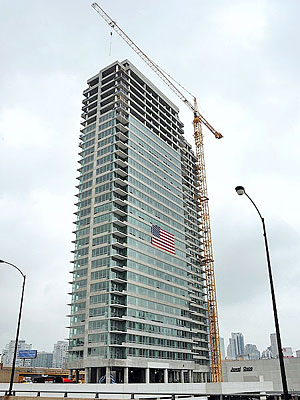
K2, a Fifield apartment building at 365 North Halsted Street in the Fulton River District
Apartment rents have been rising and will keep going up for the near future—but at three different rates in three different strata of the market, according to speakers at last week’s Lincoln Park Builders Real Estate Forum ’12. In the fourth and bottom layer, they will remain flat.
In the splashy luxury buildings that have been going up downtown, rents are up about 7.5 percent over a year before, as detailed in Crain’s Chicago Business on Tuesday. Now running $2.58 per square foot—with a few superdeluxe buildings going for more than $3 a foot—they’re at their highest rate ever.
Beneath them are the so-called Class B buildings, not only downtown but also throughout the city, where rents are up 5 percent. (Their per-square-foot charges vary widely.) One rung down, apartments in struggling neighborhoods are renting for about 2.5 to 3.5 percent more than a year ago, after nearly a decade of essentially standing still, according to Ari Golson, an investor in those neighborhoods’ rental properties. Rents there, he says, are in the range of 80 cents a square foot.
Beneath them all is a level where rents are still flat and are likely to stay that way until a full economic recovery arrives. “These are demographic groups who are really suffering, where unemployment is much more significant than the average, and where it’s hard to find folks who can pay rent,” Golson says. “There’s a lot of distress there, and rents aren’t going to go up.”
Movement in the top three strata is largely dictated by employment and income growth (or lack of it), says Steven Fifield, the head of Fifield Realty Partners. In spring 2013, his company will complete K2, its fifth rental building in the K Station cluster in the Fulton River District. Those units are all targeted to high-end renters.
“Our renters are mostly college-educated people in white-collar jobs, where unemployment is at 4.5 percent,” says Fifield. “But your average working person, with a little college or high school or less [education] has had no income growth really in the last 12 years, and they’re seeing over 9 percent unemployment. So it’s hard to push rents up.”
Demand for rentals is very strong in the third-from-the-top echelon—in neighborhoods such as Kenwood and Hyde Park—Golson says. Unlike in the downtown buildings, where high demand is pushing higher rents, “these aren’t going to stretch any higher than inflation.”
One step up, in the second stratum, are neighborhoods such as Lincoln Park, Lake View, Roscoe Village, and Edgewater. Golson, whose company also has holdings there, says that “those neighborhoods are in for a couple more years of significant rent growth”—in the 5 to 7 percent range.
There and in the upper end, both Golson and Fifield say, one key factor driving demand is the lack of interest in buying a home. Because they have seen friends and family get burned by the downturn in home prices, Fifield said at the event, “renters will stay renters.” They are members of what Lee Kiser, principal of the Kiser Group and moderator of the six-member panel, called “the shell-shocked generation.”
Another major factor, in Fifield’s forecast, is job growth. He believes Mayor Emanuel’s push to bring tech jobs downtown will create appreciable job growth in the city. “That [kind of] talent prefers to live and play close to work,” he said.
That would mean high occupancy not only for Fifield’s K2 but other buildings coming online in 2012—such as the Coast at Lakeshore East; 500 North Lake Shore Drive; 1225 Old Town, just north of downtown; and some other places planned for later delivery.
And higher occupancy will naturally mean higher rents.
Photograph: Courtesy of Fifield Realty Partners


